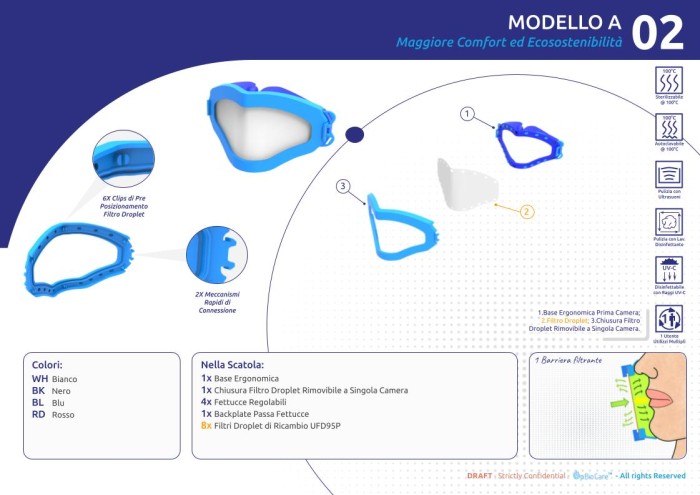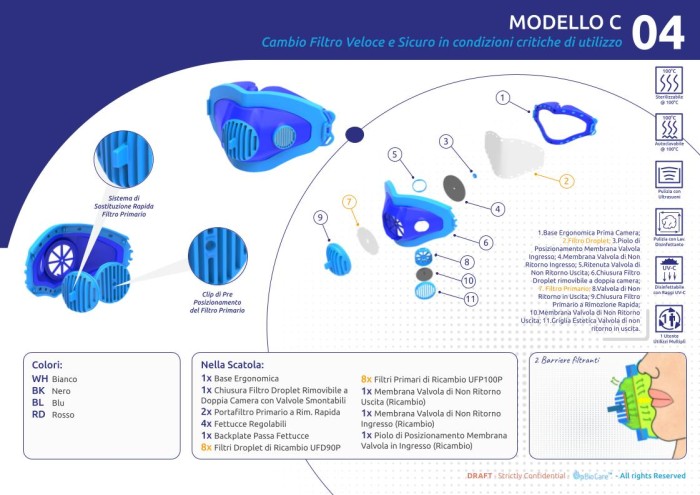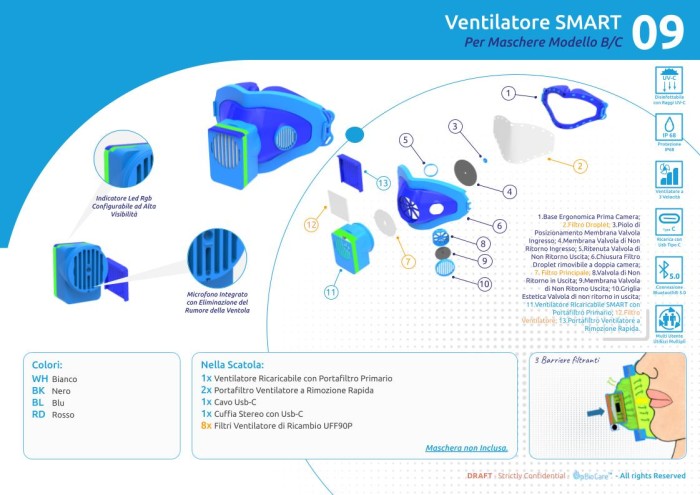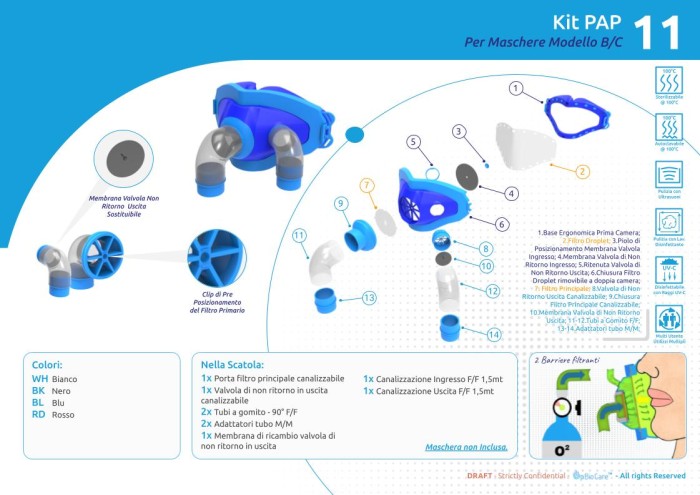
Home List your patent My account Help Support us
UPNIVERSAL® - MODULAR DUAL CHAMBER REUSABLE FILTERING FACE MASK
[Category : - Wearing apparel- HEALTH- Life-saving; Fire-fighting]
[Viewed 2426 times]
The present invention relates to the field of personal protective equipment (PPE), particularly respiratory masks used to filter the air breathed by people wearing such masks.
More precisely, it refers to a conveniently employable bidirectional filtration device to be worn profitably and advantageously, improving durability, production speed, safety and recyclability thereof.
Technical problem identification:
Since the primary object of respiratory masks is to prevent the wearer from contaminating the surrounding environment, they should be used correctly and effectively to limit the transmission of infectious agents. This is all the more true in the case of medical, paramedical or similar staff in contact with patients during surgical procedures and other medical and health care activities and, in particular, to avoid pandemic phenomena from spreading in particularly high-risk environments such as clinics/hospitals/ambulatories.
For a correct use, it is necessary to follow suitable precautions to properly wear, remove and dispose of a respiratory mask; otherwise said device, which is used to reduce the risk of contagion, can become a source of infection due to germs,
bacteria and viruses that might settle on it. Regarding its use, it is necessary to:
- Replace the mask with a new one as soon as it is damp and do not reuse disposable ones;
- Replace it without touching the front portion.
Operators using disposable masks are thus required to replace them regularly as soon as they become damp. Unfortunately, this happens quite frequently because they are typically worn in adherence to the oral and nasal cavities, thus being subject to being easily moistened. In particular they are subject to a latent but constant and significant moistening action due to the common and natural emissions of a person while talking and breathing normally; not only from acute phenomena such as sneezing. And this reasonably reduces the life of most respiratory masks to a time span of a few hours.
The above-mentioned problems of limited life and frequent replacement may seem apparently negligible, since they are devices that are natively disposable and, above all, low cost, but they are of great importance in the hospital environment, especially in extraordinary circumstances such as pandemic events that put the healthcare system structures and staff under great stress. In fact, in these circumstances two serious problems can arise:
a lack of mask supply such that it would be desirable to make the best use of the few masks available in stock and, above all, to have them last longer (obviously without any loss of performance or increase in risk);
a factor of very high psychophysical stress for health care operators who, being subjected to frequent mask changes, may reasonably and understandably forget to perform the replacement operation, exposing patients and themselves to greater risks of contagion and spread.
The above-mentioned problems, despite being prominent and crucial, are not the only ones afflicting this type of objects: important problems are reported about how these devices fit and in particular problems related to their proper positioning and stable adherence to the face. Although surgical masks are designed to prevent the wearer from contaminating the surrounding environment, it is obviously desirable that they also provide a reasonable, even if limited, barrier effect for the wearer in contaminated and hostile environments. Unfortunately, commercially available masks, being produced in a few formats and in standard sizes and being easily deformable, do not often perfectly adhere to the face and above all are poorly adaptable to the features and dimensions of the face and particularly of the nose, mouth and to the proportions between them. As a result, they can often allow viruses or harmful agents to pass through conspicuous and macroscopic side apertures that tend to form during use.
Finally, a further problem with commercially available respiratory masks, especially when using disposable devices, is the recyclability of the product itself. As described above, the aforesaid masks are made of at least 3 different materials, which are not separated for sanitary reasons.
Objects of the invention:
The main task of the present invention is to provide a conveniently employable device which allows to solve or at least considerably reduce the drawbacks set forth above. In said context, the Applicant has identified a system for reducing the bacteriological or viral proliferation by preserving one or more filters exposed with the external environment through the use of a pre-chamber provided with an anti splash or anti-droplet filter allowing separating said pre-chamber from a traditional respiratory chamber. This mask that can be sterilised and reused with interchangeable filters, enables dramatically containing costs by reducing the production operations of the replaceable filtering components, ensuring a longer life and at the same time
quality of results, both in terms of safety and in terms of adaptability, usability and ease of use.
Such results are achieved with the double-chamber protective mask according to the present invention, the essential features of which are defined in the claims appended to this description and the main objects of which are summarized below.
The main object of the present invention is to provide a device that allows to separate the filtering tissue in contact with the mouth and nose from the filtering device in contact with the external environment by a separation chamber, limiting the moistening of the filtering material in contact with the external environment and thus prolonging the duration and reliability of use.
A further object of the present invention is to provide a device that allows to optimally adhere to the face.
A further object of the present invention is to provide a device having removable disposable filters and that allows to possibly use glasses in an optimal manner.
A further object of the present invention is to provide a device that allows to replace filters easily and safely.
A further object of the present invention is to provide a device that can be used in a variety of conformations.
A further object of the present invention is to provide a device that allows to apply one or more check valves for optimal air escape with or without using an additional filter.
A further object of the present invention is to provide a device that allows to apply a battery-powered forced recirculation device with or without using an additional filter.
A further object of the present invention to provide a device that allows to connect the mask to a fixed forced ventilation device or system with or without using an additional, possibly remote, filter.
A further object of this invention is to provide a product which, with respect to the above listed features, can be adapted to further commercial needs regardless of the environment of use.
Finally, a further object of the present invention is to make, following the same objects described in the previous points, a comfortable mask made of an anti allergic plastic material which can be sterilised, easy to use, assemble and with low production costs.
Financial information
Our company is highly receptive to exploring potential collaborations with partners interested in acquisition, joint development, or licensing of our patented technologies.
It is worth noting that our patent has been extended to several offices, which are not yet visible on the WIPO website like:
UIBM; Priority.
WIPO PCT;
EPO PCT;
EAPO PCT;
USPTO
CTPO
JPO
IPO
APO
MPTO
IPOPHL
CIPC
ILPO
CIPO
MYIPO
DJKI
KIPO
It's worth mentioning that the company has received all fully positive opinions for this patent.
Moreover, we have associated the international trademark 'Upniversal,' several European designs, and multiple web domains with this patent to strengthen our market presence.
Asking price:
Make an offer
Make an offer





[ Home | List a patent | Manage your account | F.A.Q.|Terms of use | Contact us]
Copyright PatentAuction.com 2004-2017
Page created at 2026-01-02 19:41:29, Patent Auction Time.
 Patent publications:
Patent publications: WO 2021224734
WO 2021224734 AU 2021266892
AU 2021266892 EP 21727222
EP 21727222 CN 115485035
CN 115485035 CA 3177343
CA 3177343 Great invention
Great invention